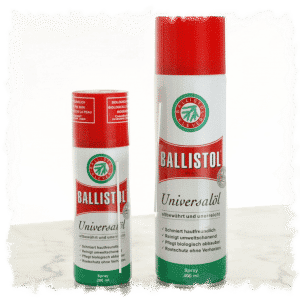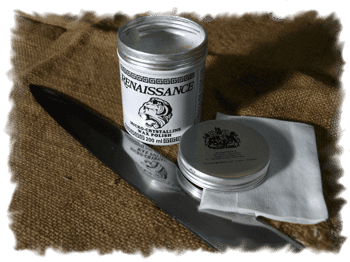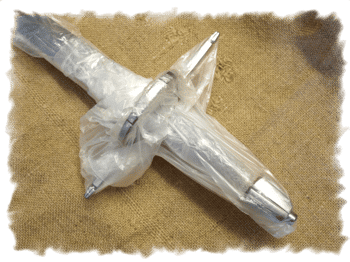Sword Care
All functional swords made today are still made of carbon steel. No discoveries or breakthroughs have been made in materials since the early middle ages, which would affect manufacturing of swords. Nowadays we know how steel behaves at the molecule-level and the rules and methods how to harden and heat treat steel, but still every sword owner has to make sure that oxygen cannot get to the rust-prone carbon steel. Stainless steel is a good material for many tools and uses, but unfortunately it is no good as a material for a functional sword.
We need a layer of protection on the carbon steel just like sword owners needed in medieval times. Light rust on the surface does not affect the structural integrity of the sword, but is mainly an aesthetic issue, but when if the rust has a chance to penetrate the weapon further, it will in time weaken it dramatically. When there is some oil or wax on the steel, oxygen cannot get to the iron and the steel stays rust free. The quality of steel doesn’t affect this and the situation is the same regardless of the manufacturer or the quality of the blade. These instructions can be used to protect any carbon steel item. When doing maintenance on an edged weapon, always keep your wits about you, and exercise common sense.
Protection Using Oil
A sword hanging on the wall as a decoration needs new oil only once or twice a year, depending on the oil type used. Oil evaporates slowly off the blade and new oil needs to be added before the protective layer has vanished. New layer of oil is also always needed when the sword has been handled. If you strike for example a cardboard box with the sword, all of the oil will be caught in the cardboard and the blade is left unprotected.
When the blade is touched with bare fingers, some of the natural grease/oil of the skin is left on the blade (fingerprint). This grease is slightly acid and corrosion follows suit. Just one night uncleaned will leave a corroded fingerprint on your sword. When your friends have awed and handled your sword, wiping the sword with an oily rag is in order. Don’t forget any other steel parts, such as the cross-guard or the pommel. Any fluff-free cloth is suitable for the purpose, for example old t-shirts or sheets are ideal.
When stored inside at room temperatures an adequate protection is for example a silicone-oil that is widely available. Silicone is a very light oil but protects your blade from oxygen as well as thicker oils. Light oil doesn’t mess your home as much as thicker oils and is easy to handle. It’s wise to keep a piece of cloth and the oil can for example in a zip lock bag nearby your sword. The oily cloth doesn’t stain your furniture from inside a plastic bag and all accessories are in one place and always ready for use. If you use thicker oil/grease to protect you blade it may smudge/stain your home more easily but on the other hand it evaporates more slowly than light oil from the surface of the blade and new oil needs to be added less frequently.
Selecting the right oil is not critical, as almost any oil will protect your weapon from the effects of oxygen. Many enthusiasts like to use oils designed for firearms. Oils designed for firearms are good for edged weapons also, but the special properties of oil needed for firearms increase the price of the product but do not help protect your edged weapons any better than the cheaper alternatives. If you use any clear, non-organic, oil you should have no problem with rust on your sword.
You can protect all of your steel items with Ballistol-oil
Protection Using Wax
By using Renaissance Wax you can protect your sword with one treatment for even decades to come. Thicker and harder layer of wax does not evaporate away like oil and the protective layer remains intact for long periods of time. Hard wax layer also protects against fingerprints. Wax coated blade can be handled with bare hands without risk of corrosion as all fingerprints will be on the wax and not on the steel. One benefit of wax is that the surface of the blade remains dry and the sword collects dust much less than oily surfaces that always have some stickiness to them. You can protect your whole sword with wax; leather, bone and wood can be protected from environmental oxidative and corrosive properties as well as the steel parts. Renaissance wax creates a comprehensive protective layer around the item and we recommend that you protect your whole weapon collection using Renaissance wax.
Although the wax layer is not evaporated away from the surface, it does, however, wear off mechanically if the sword is used in training. While on the wall the waxed sword does not require any maintenance, but if used in training the wax coating will need to be reapplied to all surfaces that have had direct battle contact.
Using Renaissance Wax you can protect all of your valuables. This wax is widely used by museums as it forms long-lasting protective coating on the surface of items that need to be conserved for generations to come.
Storage
For long periods of storage, the sword should not under any circumstances be left inside its leather sheath. Storage inside a wooden scabbard however is ok once properly oiled. Leather always contains some moisture and when the temperature varies some moisture condensates on points were the sword touches the sheath. This causes rusting on the blade.
It is wise to oil the sword well or coat it with Renaissance Wax, wrap it in plastic and put in storage next to its scabbard. If you decide to use oil, use one of the thicker oils/greases to ensure a safe and long storage. Vaseline is good long-term oil to use. Light oil evaporates off and does not necessarily give good enough a protection in the long-term.
When you put a sword in storage for a long period of time, oil or wax the sword thoroughly and wrap it in plastic.



